Have you ever wondered how different cultures infuse their weddings with joy, celebration, and a touch of prosperity? One enchanting tradition that spans the globe is the Money Dance, a vibrant and meaningful part of many wedding celebrations. This tradition, while varying in its specifics from one culture to another, generally involves guests giving money to the newlyweds as they dance, symbolizing their support and blessings for a prosperous life together.
In this article, we’ll explore the rich tapestry of the Money Dance tradition, its origins, and how it’s celebrated in various cultures. Whether you’re planning your wedding or just love learning about wedding customs, join us on this fascinating journey through the world of the Money Dance. From the lively Polish Apron Dance to the festive Armenian Wedding Dance, each culture adds its unique flavor to this time-honored tradition. We’ll also delve into how modern couples are adapting this tradition to suit their contemporary tastes, ensuring that the Money Dance remains a cherished part of weddings for generations to come.
What is the Money Dance?
Definition and Origin
The Money Dance, known by various names across different cultures, is a wedding tradition where guests dance with the newlyweds and offer them monetary gifts. This tradition, while its exact origins are shrouded in history, is believed to have started as a way to provide financial support to the newlyweds at the start of their joint life. It’s a practice that transcends geographical boundaries, with variations found in cultures across Europe, Asia, Africa, and the Americas.
Symbolic Meaning
At its core, the Money Dance is more than just a festive part of the wedding reception; it’s a symbolic act. It represents the community’s support for the couple, not just in terms of financial blessings but also in love and good wishes. The act of dancing and gifting money is a powerful gesture of unity, showing the couple that their family and friends are there to support them as they embark on their new life together. In many cultures, it’s also seen as a harbinger of good fortune and prosperity, a wish for the couple’s future filled with abundance and happiness.
How Different Cultures Celebrate the Money Dance
The Money Dance, while universally symbolizing good fortune and support, takes on unique characteristics in different cultures. Here’s a glimpse into how various cultures around the world celebrate this tradition:
Polish Apron Dance
In Poland, the tradition is known as the “Apron Dance.” The bride typically wears an apron, and guests pin money to it as they take turns dancing with her. This practice not only brings financial blessings but also is a fun and interactive way for guests to engage with the bride.
Nigerian Money Spray
In Nigerian weddings, particularly among the Yoruba, Igbo, and Hausa tribes, the Money Spray is a vibrant and energetic part of the celebration. Guests “spray” or toss money at the dancing couple, symbolizing a shower of blessings, prosperity, and joy.
Filipino Money Dance
The Filipino version involves pinning money onto the garments of the bride and groom. This act is a poignant gesture, symbolizing the community’s role in supporting and building the couple’s future together.
Portuguese Money Dance
In Portugal, the Money Dance involves a slightly different twist. Guests pay for the privilege of dancing with the bride or groom, with the collected money serving as a nest egg for the couple’s new life.
Greek Money Shower
The Greek Money Shower is a lively part of the reception where guests throw money at the dancing couple, wishing them a prosperous life. It’s a joyous and exuberant expression of love and good fortune.
Cajun Money Dance in Louisiana
In Louisiana’s Cajun culture, guests pin money to the bride and groom’s clothing during the dance. This tradition is a cornerstone of wedding celebrations in Cajun communities, blending joy with cultural heritage.
Armenian Wedding Money Dance
Armenian weddings also feature a Money Dance, where guests present monetary gifts to the couple during their dance. This tradition is a heartfelt way to wish the couple prosperity and happiness in their married life.
New Ways to Celebrate the Money Dance
As times change, so do wedding traditions. The Money Dance is no exception, with many couples finding creative ways to honor this custom while adding a modern twist.
Contemporary Twists
Today’s couples often put their personal stamp on the Money Dance, making it more reflective of their personalities and contemporary lifestyles. Some opt for more upbeat, modern music, while others might choreograph a special dance to make the moment even more memorable.
Technology Integration
In an age where digital transactions are commonplace, some couples are integrating technology into the Money Dance. Instead of physical cash, guests can send their gifts via money transfer apps like Venmo or PayPal. This not only simplifies the process but also accommodates guests who don’t carry cash.
Alternative Ideas
For those who prefer a non-monetary approach, the Money Dance can also be adapted to fit this preference. Couples might ask guests to write down wishes or advice and pin these notes in place of money. This way, the dance becomes a collection of heartfelt messages and good wishes, creating a lasting keepsake for the couple.
Inclusivity and Sensitivity
Modern couples are also mindful of inclusivity and cultural sensitivity. They often take steps to ensure that the tradition respects their diverse guest list and is presented in a way that is welcoming to all attendees.
Planning Your Weddings Money Dance
Incorporating the Money Dance into your wedding requires thoughtful planning and consideration to ensure it aligns with your wedding’s style and your guests’ comfort. Here are some tips to help you seamlessly integrate this tradition into your celebration.
Etiquette and Tips
- Timing: Choose a time during the reception when the energy is high. Typically, the Money Dance is held after the main meal and before the cake cutting.
- Communication: Make sure your guests are aware of the tradition, especially if it’s not common in your culture. A brief explanation in the wedding program or a mention by the DJ or emcee can be helpful.
- Inclusivity: Be mindful of guests’ financial situations. Make it clear that participation is voluntary and that the act of dancing with the couple is more important than the monetary gift.
Communication with Guests
- Prior Information: Inform your guests about the Money Dance in advance, possibly through your wedding website or invitations. This gives them time to prepare if they wish to participate.
- Cultural Explanation: If your guests come from diverse backgrounds, a short explanation of the tradition’s significance can enhance their understanding and appreciation.
- Alternative Participation: Offer alternative ways for guests to participate, such as writing notes or using digital payment methods, to ensure everyone feels included.
The Money Dance in Popular Culture
The Money Dance, while deeply rooted in tradition, has also found its way into popular culture, reflecting its enduring appeal and significance in our collective imagination.
Media References
- Movies and TV Shows: The Money Dance often features in films and TV shows depicting weddings, sometimes as a poignant moment of cultural significance, and other times as a light-hearted, joyous scene. These portrayals help to popularize and spread awareness of the tradition beyond its cultural origins.
- Literature: In books, the Money Dance is sometimes used as a narrative device to explore themes of community, family, and cultural heritage, offering readers a glimpse into the customs that shape our social celebrations.
- Social Media: Platforms like Instagram and YouTube have allowed couples to share their Money Dance experiences with a wider audience, showcasing the diversity of this tradition in real-life weddings around the world.
Impact on Society
The representation of the Money Dance in popular culture has played a significant role in its adaptation and persistence. It not only educates people about this beautiful tradition but also inspires couples to incorporate it into their weddings, often with their unique twist. As a result, the Money Dance continues to evolve while maintaining its core significance as a symbol of community support and good wishes for the newlyweds.
Conclusion
The Money Dance is a beautiful, time-honored tradition that adds a unique and joyous element to wedding celebrations across the globe. From the lively steps in a Polish Apron Dance to the heartfelt notes in a modern, tech-savvy adaptation, this tradition continues to evolve while maintaining its core essence of community, support, and good fortune.
Contact us at the Regency Event Venue to celebrate your wedding. Our large dancefloor and incredible lighting provide the best ambiance for your wedding money dance.




